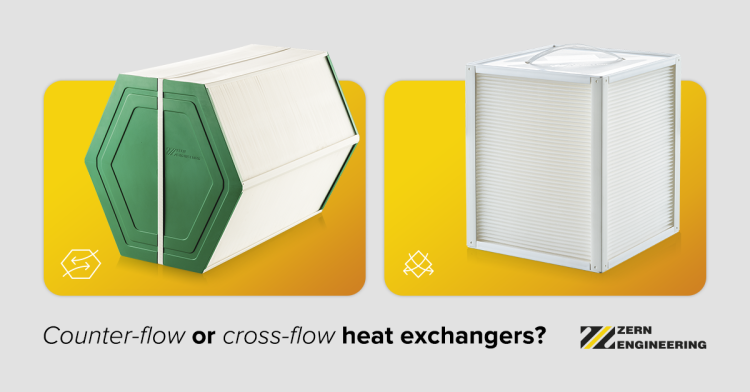| Counter-flow or cross-flow heat exchangers? |

When it comes to air-to-air plate heat exchangers, the way air streams move makes a big difference. The two most common designs – counter-flow and cross-flow – each have their own strengths. Let’s break it down.
💨 Counter-flow heat exchangers
In a counter-flow design, the warm and cold air streams move in opposite directions, separated by thin conductive plates. This setup allows for maximum temperature difference and longer contact time between air streams.
✅ Advantages:
– High heat recovery efficiency (up to 90%)
– Excellent for cold climates or ultra-low-energy buildings
– Reduces heating/cooling loads significantly
🔧 Considerations:
– Slightly more complex construction
– Can take up more space in some installations
📌 Best suited for:
1. Passive houses
2. Energy-efficient residential systems
3. Applications where energy savings are a top priority
💨 Cross-flow heat exchangers
In a cross-flow setup, the two air streams move perpendicularly to each other. While the temperature exchange is slightly less efficient, the design is compact, simple and cost-effective.
✅ Advantages:
– Compact and easy to install
– Lower manufacturing cost
– Good airflow performance with low pressure drop
🔧 Considerations:
– Lower heat recovery efficiency (typically 60-80%)
– May require airflow balancing in sensitive systems
📌 Best suited for:
1. Commercial and office buildings
2. Retrofitted ventilation systems
3. Projects with limited space or tighter budgets
So… Which one is better?🤔
There’s no one-size-fits-all answer- and that’s the beauty of it.
Both counter-flow and cross-flow heat exchangers are valuable tools in designing efficient, comfortable, and sustainable ventilation systems.
👉 Choose counter-flow for maximum energy savings.
👉 Choose cross-flow for practicality, compactness and economy.
Both get the job done – just with a different approach☺️

